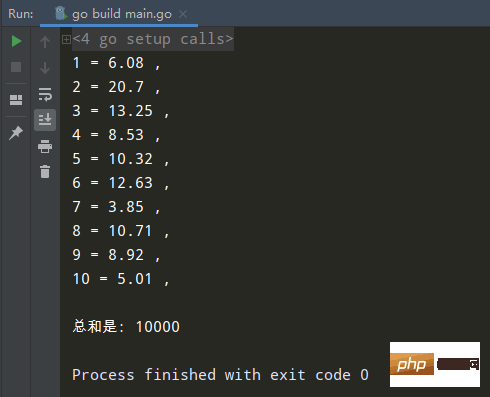 Backend Development
Backend Development
 Golang
Golang
 Golang implements the double mean algorithm and the method of grabbing red envelopes
Golang implements the double mean algorithm and the method of grabbing red envelopes
Golang implements the double mean algorithm and the method of grabbing red envelopes
The following column Golang Tutorial will introduce to you how golang implements the double mean algorithm and grabs red envelopes. I hope it will be helpful to friends in need!

Everyone is definitely familiar with grabbing red envelopes, but have you ever thought about how to grab red envelopes?
First of all, we have to clarify the requirements and the constraints of the requirements. There are three main restrictions on red envelopes
a. The total amount grabbed = the total amount of red envelopes, no more or less
b. The minimum value is 0.01 yuan, that is, everyone has a share
c. Everyone grabs The amount of red envelopes received should be averaged as much as possible
Suppose the total amount is M yuan, N people, the amount of each grab = (0, (M/N) *2), for example, still The conditions mentioned before are that the amount is 100 and the number of people is 10.
The amount that the first person grabs is (0,20). According to the normal distribution, the value grabbed should be around 10. The probability of it being much lower than 10 is very high. Small, the sum of the probability is also much greater than 10. It is assumed that the value grabbed by the first person is 10;
The amount grabbed by the second person is (0,90/9 *2)=(0,20) , the same as the first person, the second person’s red envelope amount should also be around 10;
for the remaining people, and so on.
Checked out "Architecture Design of WeChat Red Envelopes", which is the method used. However, this algorithm is not perfect. If the first person grabs 15, the range of the second person is (0,18.89). If the second person grabs a high value, it will be detrimental to the people behind.
Next, let’s take a look at how to implement this double mean algorithm in golang
package mainimport (
"fmt"
"math/rand"
"time")func main() {
//10个人 抢10000分 也就是10个人抢100块钱
count,amount := int64(10),int64(10000)
remain := amount
sum := int64(0)
for i := int64(0);i<count;i++ {
x := DoubleAverage(count-i, remain)
remain -= x
sum += x
fmt.Println(i+1,"=",float64(x)/float64(100),", ")
}
fmt.Println()
fmt.Println("总和是:",sum)}//提前定义能抢到的最小金额1分var min int64 = 1//二倍均值算法func DoubleAverage(count,amount int64) int64 {
if count == 1 {
return amount }
//计算出最大可用金额
max := amount - min*count //计算出最大可用平均值
avg := max / count //二倍均值基础上再加上最小金额 防止出现金额为0
avg2 := 2 * avg + min //随机红包金额序列元素,把二倍均值作为随机的最大数
rand.Seed(time.Now().UnixNano())
x := rand.Int63n(avg2) + min return x}Let’s take a look at the results:

The above is the detailed content of Golang implements the double mean algorithm and the method of grabbing red envelopes. For more information, please follow other related articles on the PHP Chinese website!

Hot AI Tools

Undresser.AI Undress
AI-powered app for creating realistic nude photos

AI Clothes Remover
Online AI tool for removing clothes from photos.

Undress AI Tool
Undress images for free

Clothoff.io
AI clothes remover

AI Hentai Generator
Generate AI Hentai for free.

Hot Article

Hot Tools

Notepad++7.3.1
Easy-to-use and free code editor

SublimeText3 Chinese version
Chinese version, very easy to use

Zend Studio 13.0.1
Powerful PHP integrated development environment

Dreamweaver CS6
Visual web development tools

SublimeText3 Mac version
God-level code editing software (SublimeText3)

Hot Topics
 1375
1375
 52
52
 How to safely read and write files using Golang?
Jun 06, 2024 pm 05:14 PM
How to safely read and write files using Golang?
Jun 06, 2024 pm 05:14 PM
Reading and writing files safely in Go is crucial. Guidelines include: Checking file permissions Closing files using defer Validating file paths Using context timeouts Following these guidelines ensures the security of your data and the robustness of your application.
 How to configure connection pool for Golang database connection?
Jun 06, 2024 am 11:21 AM
How to configure connection pool for Golang database connection?
Jun 06, 2024 am 11:21 AM
How to configure connection pooling for Go database connections? Use the DB type in the database/sql package to create a database connection; set MaxOpenConns to control the maximum number of concurrent connections; set MaxIdleConns to set the maximum number of idle connections; set ConnMaxLifetime to control the maximum life cycle of the connection.
 Comparison of advantages and disadvantages of golang framework
Jun 05, 2024 pm 09:32 PM
Comparison of advantages and disadvantages of golang framework
Jun 05, 2024 pm 09:32 PM
The Go framework stands out due to its high performance and concurrency advantages, but it also has some disadvantages, such as being relatively new, having a small developer ecosystem, and lacking some features. Additionally, rapid changes and learning curves can vary from framework to framework. The Gin framework is a popular choice for building RESTful APIs due to its efficient routing, built-in JSON support, and powerful error handling.
 How to use gomega for assertions in Golang unit tests?
Jun 05, 2024 pm 10:48 PM
How to use gomega for assertions in Golang unit tests?
Jun 05, 2024 pm 10:48 PM
How to use Gomega for assertions in Golang unit testing In Golang unit testing, Gomega is a popular and powerful assertion library that provides rich assertion methods so that developers can easily verify test results. Install Gomegagoget-ugithub.com/onsi/gomega Using Gomega for assertions Here are some common examples of using Gomega for assertions: 1. Equality assertion import "github.com/onsi/gomega" funcTest_MyFunction(t*testing.T){
 What are the best practices for error handling in Golang framework?
Jun 05, 2024 pm 10:39 PM
What are the best practices for error handling in Golang framework?
Jun 05, 2024 pm 10:39 PM
Best practices: Create custom errors using well-defined error types (errors package) Provide more details Log errors appropriately Propagate errors correctly and avoid hiding or suppressing Wrap errors as needed to add context
 How to save JSON data to database in Golang?
Jun 06, 2024 am 11:24 AM
How to save JSON data to database in Golang?
Jun 06, 2024 am 11:24 AM
JSON data can be saved into a MySQL database by using the gjson library or the json.Unmarshal function. The gjson library provides convenience methods to parse JSON fields, and the json.Unmarshal function requires a target type pointer to unmarshal JSON data. Both methods require preparing SQL statements and performing insert operations to persist the data into the database.
 Golang framework vs. Go framework: Comparison of internal architecture and external features
Jun 06, 2024 pm 12:37 PM
Golang framework vs. Go framework: Comparison of internal architecture and external features
Jun 06, 2024 pm 12:37 PM
The difference between the GoLang framework and the Go framework is reflected in the internal architecture and external features. The GoLang framework is based on the Go standard library and extends its functionality, while the Go framework consists of independent libraries to achieve specific purposes. The GoLang framework is more flexible and the Go framework is easier to use. The GoLang framework has a slight advantage in performance, and the Go framework is more scalable. Case: gin-gonic (Go framework) is used to build REST API, while Echo (GoLang framework) is used to build web applications.
 How to solve common security problems in golang framework?
Jun 05, 2024 pm 10:38 PM
How to solve common security problems in golang framework?
Jun 05, 2024 pm 10:38 PM
How to address common security issues in the Go framework With the widespread adoption of the Go framework in web development, ensuring its security is crucial. The following is a practical guide to solving common security problems, with sample code: 1. SQL Injection Use prepared statements or parameterized queries to prevent SQL injection attacks. For example: constquery="SELECT*FROMusersWHEREusername=?"stmt,err:=db.Prepare(query)iferr!=nil{//Handleerror}err=stmt.QueryR



